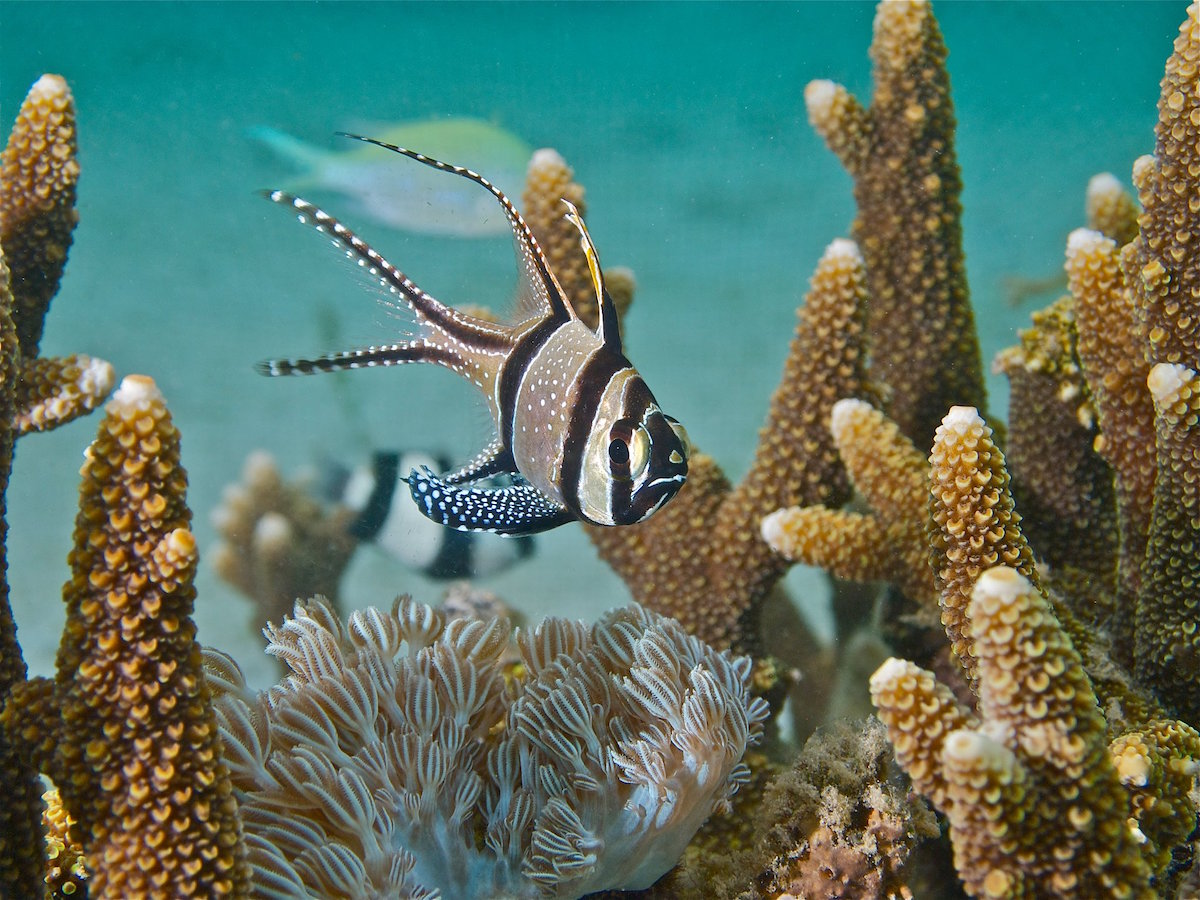- The US National Marine Fisheries Service (NMFS) published a final rule Wednesday listing the Banggai cardinalfish (Pterapogon kauderni) as “threatened” under the Endangered Species Act.
- The species is extremely popular among aquarium hobbyists, and scientists have raised concerns that overharvesting in its tiny native range in Indonesia’s Banggai Islands threatens its survival.
- Because the Banggai cardinalfish will be listed as “threatened” and not “endangered,” NMFS will place no immediate restrictions on its trade or possession, but may do so at some point in the future.
The US National Marine Fisheries Service (NMFS) published a final rule Wednesday listing the Banggai cardinalfish (Pterapogon kauderni) as “threatened” under the Endangered Species Act (ESA). The species will be the first saltwater aquarium fish listed, and only the twenty-eighth marine fish.
Because the Banggai cardinalfish will be listed as “threatened” and not “endangered,” NMFS will place no immediate restrictions on its trade or possession. However, the agency may initiate a rulemaking process to determine prohibitions at some point in the future.
The Banggai cardinalfish is small but stunningly beautiful, with showy fins, a silvery to bronze body, three jet-black vertical bars, and constellations of bright spots. A scientist first collected two Banggai cardinalfish in Indonesia’s Banggai Islands in 1920. It wasn’t until 1933 that the specimens were described in the scientific literature. The species is endemic to an extremely small range — its available habitat is thought to be roughly the size of Los Angeles Harbor, around 34 square kilometers. It was largely forgotten until 1994 when renowned ichthyologist Gerry Allen with the NGO Conservation International, “re-discovered” it. The following year, the species made its debut to US aquarium hobbyists at the Marine Aquarium Conference of North America, where it was described as a nearly ideal aquarium species.

As a direct result of its popularity, combined with little to no fishery management in the Banggai Islands, the harvest of the species quickly became unsustainable. In 2002, researchers estimated at least 600,000 fish were harvested annually. By 2004, those same researchers raised serious concerns about the survival of the species if collection continued unabated. At the time, the species population size was estimated at 2.4 million fish.
In 2007, the International Union for Conservation of Nature (IUCN) listed the Banggai cardinalfish as “endangered.” In the same year, however, the US withdrew its proposal to list the species under Appendix II of the Convention on International Trade in Endangered Species of Wild Fauna and Flora because of Indonesian opposition. An Appendix II listing would have regulated trade.

The Banggai cardinalfish continued to gain popularity, and, as the price per fish dropped, it became one of the US’s top ten most imported marine aquarium fishes. Most of the fish were arriving by way of poor supply chains with high mortality from a fishery that remained largely unregulated. By 2005, researchers estimate that as many as 900,000 fish were harvested annually. A 2008 effort by concerned aquarists — supported by the Marine Aquarium Societies of North America and much of the hobby media — called for a grassroots boycott of wild-harvested Banggai cardinalfish. Even so, imports of the species actually increased relative to other species.
In 2013, the Santa Fe-based advocacy group WildEarth Guardians petitioned NMFS to list the species under the ESA. The following year, NMFS determined that there was enough information in the petition to warrant an in-depth, peer-reviewed status review of the species. The agency published that status review in August 2014, and proposed to list the species as “threatened” under the ESA the following December.
The aquarium trade generally opposed the proposed listing, mainly because in 2013 a Thai facility had begun producing enough aquacultured Banggai cardinalfish to meet almost the entire US demand. Many aquarium trade advocates argued an ESA listing was unnecessary given the dramatic shift to aquacultured Banggai cardinalfish.
NMFS acknowledged in its proposed rule that “the threat of overharvest has been and will likely continue to be reduced in the future.” But the agency still found that the synergistic effect of all threats, including more than a decade of overharvest and ongoing habitat destruction in the species’ tiny native range, placed the Banggai cardinalfish at a moderate risk of extinction and justified the listing.
“Providing protections for the Banggai cardinalfish is crucial because demand for aquarium fish in the United States is a chief cause of this imperiled species’ decline,” said Taylor Jones, WildEarth Guardians’ endangered species advocate.

Jones believes additional protective regulations are necessary, but she said they need to be considered carefully. For example, she said NMFS should quickly finalize regulations prohibiting the import of species removed from the wild, saying, “Endangered Species Act protection will mean much less for these fish if it does not address the main threat: collection from the wild for the aquarium trade.”
When it comes to aquacultured fish, however, Jones acknowledged that the response might need to be more nuanced. “We’re concerned that allowing trade in aquacultured fish would provide ‘cover’ for illegal trade in wild-caught fish,” Jones told Mongabay, but she also expressed concern that a ban on aquaculture might wind up inadvertently creating more demand for wild fish.
There is no timeframe for NMFS to determine whether or not additional protective regulations are necessary for the Banggai cardinalfish, and so both supporters and opponents of the listing wait.
“This is a unique situation in that it is the first aquarium fish listed,” said Jones. “In addition, the aquaculture industry has changed rapidly since the petition was submitted. We want NMFS to do what is best for the species, taking all those factors into account.”
Citations
Koumans, F.P. (1933). On a new genus and species of Apogonidae. Zoologische Mededelingen 16:78.